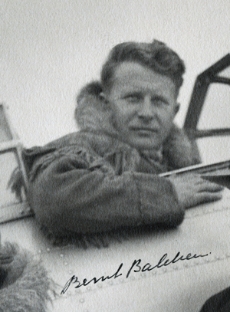Did you know that when the American Richard E. Byrd flew over the South Pole in 1929, a Norwegian was at the controls?
It was the 30-year-old pilot Bernt Balchen from Kristiansand who flew the plane safely from the Ross Ice Shelf to the South Pole and back to the Ross Ice Shelf.
 Bernt Balchen. Photo: Norwegian Polar Institute
Bernt Balchen. Photo: Norwegian Polar Institute
When Roald Amundsen and Lincoln Ellsworth disappeared with both aircraft and crew during their attempt to reach the North Pole in 1925, the Norwegian Armed Forces organised a rescue mission. One of the people searching under the leadership of lieutenant Finn Lützow-Holm was the young pilot Bernt Balchen (1899-1973) from Kristiansand.
Amundsen, Riiser-Larsen and the rest of the expedition managed to get themselves to safety on the aircraft N-24, and the rescue mission was aborted. But Bernt Balchen had not done his last flying in polar regions. When Amundsen made his attempt to reach the North Pole with the airship Norge the following year, Balchen participated as part of the ground crew. The American Richard Evelyn Byrd was in Svalbard at the time of the Norge expedition. The presence of the American team caused some consternation among Amundsen and his men, but the two expeditions established a polite relationship. Byrd claimed to have reached the North Pole by air 9 May 1926 in a Fokker F-VII triple-engine plane, but this claim was later strongly disputed.
Balchen wanted to fly – a wish Amundsen could not accommodate – so he approached Byrd. He worked for a while as test pilot for the Fokker factory in the US, and in 1927, Byrd, Balchen, Bert Acosta, and George Noville crossed the Atlantic from New York to Ver-sur-Mer in the north of France. There the pilot – Balchen – was forced to land on water because of poor visibility. No-one was injured in the emergency landing.
When Byrd organised an expedition to Antarctica in 1928, Balchen went along as pilot. On 28 November 1929, Balchen flew a Ford Tri-motor aircraft to the South Pole and back again from the base “Little America” on the Ross Ice Shelf. With him on board were expedition leader Byrd, co-pilot and radio operator Harold June, and photographer Ashley McKinley. To get enough lift to clear the Antarctic Plateau they were forced to dump both their rations and their fuel reserves, and it took 18 hours and 41 minutes to complete this historic flight.
Bernt Balchen continued his career as a pilot and was involved starting up Det Norske Luftfartselskap (The Norwegian Aviation Company) after its founding in 1933. Hjalmar Riiser-Larsen was head of the company. During WWII Balchen flew for the US Air Force, and was responsible for air bases in the Arctic, including bases in Canada, Greenland, and northern Sweden. He became a US citizen and served in the Air Force until 1956. After that he worked as consultant and expert on flying under polar conditions. His expertise in this area earned him great respect from a range of specialists.
After careful calculations based on the aircraft’s capabilities and the time spent, Byrd’s claim to have reached the North Pole in 1926 was eventually refuted by Bernt Balchen in 1971. His long experience with this aircraft and his profound knowledge about flying conditions in polar regions speak in his favour.